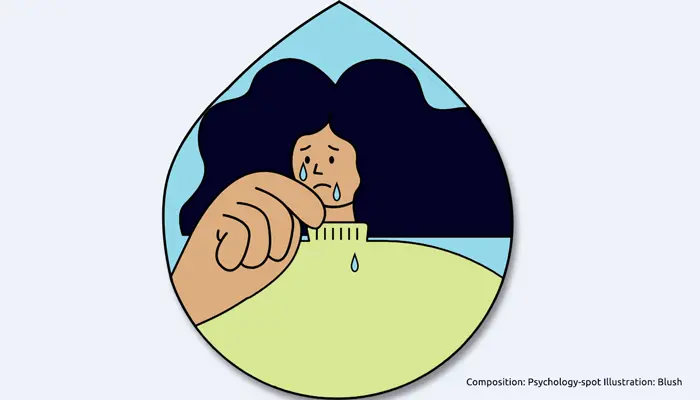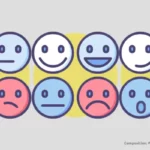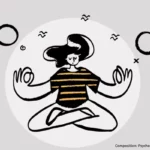
Not all emotions are equal, nor do they find the same degree of acceptance in our society. The most accepted emotion is happiness, basically because it’s a sign of security, confidence, and success. That’s why we feel compelled to feign a certain amount of happiness; we respond that we’re fine and put on a smile, even if inside we’re devastated. Happiness ensures social success, makes us win friends, and conveys an image of success.
Sadness, however, is categorized as a negative emotion, one that should be hidden and even embarrassed. Expressions of sadness, such as slumped shoulders, sad eyes, and crying, are considered signs of weakness and insecurity. However, sadness and tears also have their purpose, as perfectly exemplified by Pixar’s film “Inside Out.”
A society that always demands that we be happy and joyful, ready to take on the world, is simply tremendously unfair. Because we don’t function that way, we often get sad and cry. Stigmatizing sadness and crying only serves to make us feel even worse, to make us think we’re not strong enough to endure problems without breaking down.
However, in reality, people who dare to express their sadness and cry have greater emotional balance than those who suppress their tears and hide their feelings. An Irish proverb says, “Tears shed are bitter, but more bitter are those left unshed.”
Why are people who cry more emotionally balanced?
1. They don’t repress their emotions
If you were feeling overjoyed, would you hide your smile? If you heard a noise in your home at night, wouldn’t you be scared? So, there’s no reason to hide sadness. Only self-confident people, with high Emotional Intelligence, are able to recognize their emotions and express them, even if they are considered “negative.” It takes a lot of courage to go against the grain and express who you really are or how you feel at that moment. In fact, the philosopher Seneca famously stated that “there is no greater cause for crying than not being able to cry.”
Keeping a cool head and repressing emotions has a significant cost, not only for our psychological health but also for our physical health. Numerous studies have linked emotional repression with an increased risk of developing diseases such as asthma, hypertension, and heart disease. A study conducted at Stanford University found that people who tend to repress their emotions overreact to pressure and stress, with a greater increase in blood pressure than those classified as anxious. This indicates that this “apparent calm” is actually not good for our emotional balance.
2. They use tears to change their perspective.
Did you know that tears relieve stress, anxiety, pain, and frustration? Tears are not only the water with which we cleanse our souls, but they also cleanse our eyes, allowing us to see the situation from a different perspective. Tears don’t drain us; on the contrary, they strengthen us and allow us to grow. As the Uruguayan poet Sara de Ibáñez once said: “I will cry without haste. I will cry until I forget crying and find a smile.”
In fact, 70% of people find crying comforting. Crying allows us to view the situation from a more positive perspective. When we stop crying, our minds are clearer, and although we may find it difficult to piece together our thoughts immediately, within a few minutes we’ll calm down and be able to analyze the situation from a different perspective. This is because our emotions have been balanced, and our rational mind is ready to take action.
3. They know that crying is therapeutic
Did you know that crying stimulates the release of endorphins in our brain, hormones that not only help relieve pain but also promote a state of relaxation and peace? That’s why we feel much better and more relaxed after crying. In fact, it has been proven that it’s not advisable to stop crying but rather to let it flow, because the first stage only has an activating effect, but the second phase has a calming effect that reduces heart and respiratory rates, promoting a state of relaxation. Sometimes, crying is more beneficial than laughter.
A study conducted at the University of Florida found that crying is deeply therapeutic, especially when it acts as a “relational remedy,” that is, when it brings us closer to others and they offer us comfort. They also found that sad crying, which is meant to create new bonds after a loss, has enormous cathartic power.
4. They do not submit to social expectations
People who aren’t afraid to cry feel much freer; they’re able to express themselves without being constrained by social conventions. These people aren’t afraid of disappointing others or showing their supposed weakness, because they know that crying doesn’t really mean any of those things.
People who cry are willing to follow their instincts and don’t want to be constrained by social expectations. This awareness allows them to be freer and live by their own rules. These people are true “activists” fighting for a more emotionally healthy society, where people aren’t forced to hide their feelings.
5. They connect emotionally through tears
Crying is one of the most intimate expressions of our feelings. When we cry in front of someone, it’s as if we’re baring our soul. Therefore, tears help create a very special connection; it’s as if we’re connecting directly through our deepest selves.
When a person “accepts” that sadness, without trying to escape it or offering false words of encouragement, but simply supporting us and staying by our side, a unique connection is created. In fact, one of the functions of tears is precisely to ask for help, even indirectly, showing our helplessness and vulnerability, so that others will come closer to comfort us.
Therefore, crying and sadness should not be perceived as a sign of weakness, but rather as a sign of inner strength and mindfulness. We don’t cry because we are weak or incapable, but because we are alive and not ashamed to express what we feel.
So let’s heed the Argentine poet Oliverio Girondo’s advice: “Cry with tears running down your face, cry in torrents… Cry everything, but cry it well. (…) Cry with love, with boredom, and with joy…”
References:
Hendriks, M.C.; Rottenberg, J. & Vingerhoets, J.J. (2007) Can the distress-signal and arousal-reduction views of crying be reconciled? Evidence from the cardiovascular system. Emotion; 7: 458–463.
Rottenberg, J.; Bylsma, L. M. & Vingerhoets, J. J. (2005) Is Crying beneficial? Current Research in Psychological Science; 17(6): 400-404.
Levoy, G. (1988) Tears that Speak. Psychology Today; 22(7/8): 8- 10.
King, A. C. et. Al. (1990) The relationship between repressive and defensive coping styles and blood pressure responses in healthy, middle-aged men and women. J Psychosom Res; 34(4): 461-471.




Leave a Reply